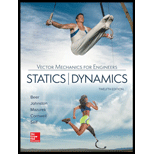
Concept explainers
Gear A weighs 1 lb and has a radius of gyration of 1.3 in.; gear B weighs 6 lb and has a radius of gyration of 3 in.; gear C weighs 9 lb and has a radius of gyration of 4.3 in. Knowing a couple M of constant magnitude of 40 lb·in. is applied to gear A, determine (a) the angular acceleration of gear C, (b) the tangential force that gear B exerts on gear C.
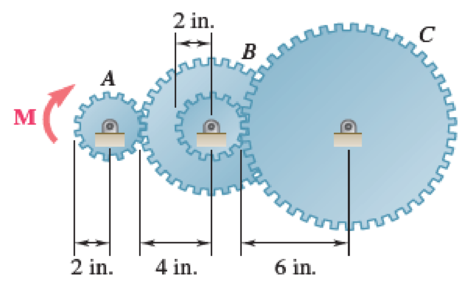
Fig. P16.37
(a)
Find the angular acceleration of the gear C
Answer to Problem 16.37P
The angular acceleration of the gear C
Explanation of Solution
The weight of the gear A
The weight of the gear B
The weight of the gear C
The radius of gyration of the gear A
The radius of gyration of the gear B
The radius of gyration of the gear C
The couple of the constant magnitude applied to gear A (M) is
The radius of the gear A
The radius of the outer gear B
The radius of the inner gear B
The radius of the gear C
The angular acceleration of the gear A is
The angular acceleration of the gear B is
The angular acceleration of the gear C is
Calculation:
Consider the acceleration due to gravity (g) is
Convert the unit of the couple (M):
Convert the unit of the radius of the gear A
Convert the unit of the radius of the outer gear B
Convert the unit of the radius of the inner gear B
Convert the unit of the radius of the gear C
Calculate the mass of the gear A
Substitute
Calculate the mass of the gear B
Substitute
Calculate the mass of the gear C
Substitute
Calculate the mass moment of inertia of the gear A
Substitute
Calculate the mass moment of inertia of the gear B
Substitute
Calculate the mass moment of inertia of the gear C
Substitute
The point of contact between A and B:
Substitute
The point of contact between B and C:
Substitute
Therefore, the angular acceleration of the gear A is
Show the free body diagram of the gear A as in Figure 1.
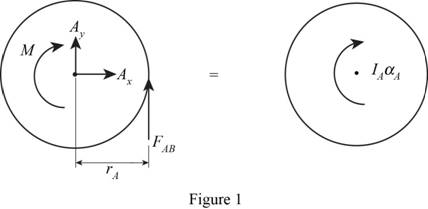
Here,
Refer to Figure 1.
Calculate the moment about point A by applying the equation of equilibrium:
Substitute
Show the free body diagram of the gear B as in Figure 2.
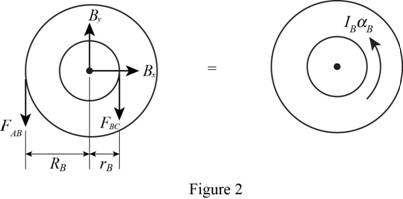
Here,
Refer to Figure 2.
Calculate the moment about point B by applying the equation of equilibrium:
Substitute
Show the free body diagram of the gear C as in Figure 3.
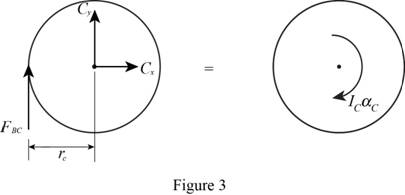
Here,
Refer to Figure 3.
Calculate the moment about point C by applying the equation of equilibrium:
Calculate the angular acceleration of the gear C
Substitute
Hence, the angular acceleration of the gear C
(b)
Find the tangential force which gear B exerts on gear C.
Answer to Problem 16.37P
The tangential force which gear B exerts on gear C
Explanation of Solution
The weight of the gear A
The weight of the gear B
The weight of the gear C
The radius of gyration of the gear A
The radius of gyration of the gear B
The radius of gyration of the gear C
The couple of the constant magnitude applied to gear A (M) is
The radius of the gear A
The radius of the outer gear B
The radius of the inner gear B
The radius of the gear C
The angular acceleration of the gear A is
The angular acceleration of the gear B is
The angular acceleration of the gear C is
Calculation:
Refer the part (a).
Calculate the tangential force which gear B exerts on gear C
Substitute
Hence, the tangential force which gear B exerts on gear C
Want to see more full solutions like this?
Chapter 16 Solutions
VECTOR MECHANICS FOR ENGINEERS W/CON >B
Additional Engineering Textbook Solutions
Automotive Technology: Principles, Diagnosis, And Service (6th Edition) (halderman Automotive Series)
Mechanics of Materials (10th Edition)
Fluid Mechanics: Fundamentals and Applications
Problem Solving with C++ (10th Edition)
Database Concepts (8th Edition)
- Quiz/An eccentrically loaded bracket is welded to the support as shown in Figure below. The load is static. The weld size for weld w1 is h1 = 6mm, for w2 h2 = 5mm, and for w3 is h3 =5.5 mm. Determine the safety factor (S.f) for the welds. F=22 kN. Use an AWS Electrode type (E90xx). I want university professor solutions O REDMI NOTE 8 PRO CAI QUAD CAMERA 140 S 101.15 Farrow_forwardResearch and select different values for the R ratio from various engine models, then analyze how these changes affect instantaneous velocity and acceleration, presenting your findings visually using graphsarrow_forwardMeh Battery operated train Coll CD Af Pair 160,000kg 0.0005 0.15 5m² 1.2kg/m³ 19 7et nong 0.98 0.9 0.88 Tesla Prated Tesla Trated Ywheel ng Jaxle. 270kW 440NM 0.45m 20 2 8.5kgm² Consider a drive cycle of a 500km trip with 3 stops in the middle. Other than the acceleration and deceleration associated with the three stops, the tran maintains. constant cruise speed velocity of 324 km/hr. The tran will fast charge at each stop for 15 min at a rate Peharge = 350 kW (ผม τ (MN 15MIN Stop w charging (350kW GMIJ restored during 15 minutes of fast charging at Calculate the battery energy Pcharge = 350kW Calculate the net energy gain per stop t 64 Determice the total battery energy required Ebat to complete the 500km trip with 3 stops. etcarrow_forward
- DO NOT COPY SOLUTION The differential equation of a cruise control system is provided by the following equation: Find the closed loop transfer function with respect to the reference velocity (vr) . a. Find the poles of the closed loop transfer function for different values of K. How does the poles move as you change K? b. Find the step response for different values of K and plot in MATLAB. What can you observe? c. For the given transfer function, find tp, ts, tr, Mp . Plot the resulting step response. G(s) = 40/(s^2 + 4s + 40)arrow_forwardAswatan gas occupies a space of 0.3 millike cube at a pressure of 2 bar and temperature of 77 degree Celsius it is indicate at constant volume at pressure of 7 parts determine temperature at the end of process mass of a gas changing internal energy change in enthalpy during the process assume CP is equal to 10 1.005 CV is equal to 0.712 is equal to 287arrow_forwardAUTO CONTROLDNO COPIED ANSWERS, SHOW FULL SOLUTION The differential equation of a DC motor can be described by the following equation Find the transfer function between the applied voltage ( Va)and the motor speed (thetadot m). What is the steady state speed of the motor after a voltage (Va = 10V) has been applied. Find the transfer function between the applied voltage (Va) and the shaft angle (thetadot m) .arrow_forward
- Auto Controls DONT COPY ANSWERS Perform the partial fraction expansion of the following transfer function and find the impulse response: G(s) = (s/2 + 5/3) / (s^2 + 4s + 6) G(s) =( 6s^2 + 50) / (s+3)(s^2 +4)arrow_forwardDerive the Laplace transform of the following functions. Use the definition of Laplace transform. f(t)=sin4t and f(t)=cos2t Auto Controlsarrow_forwardhelparrow_forward
- any help i dont understandarrow_forwardBattery operated train Mueh Groll CD Af Pair 160,000 kg 0.0005 0.15 19 5m² 1.2kg/m³ 0.98 0.9 Tet neng 0.88 Tesla Prated Tesla Trated Ywheel ng Joyle 2 270 kW 440NM 0,45m 20 8.5kg m Consider a drive cycle of a 500km trip with 3 stops in the middle. Other than the acceleration and deceleration associated with the three stops, the tran maintains. constant cruise speed velocity of 324 km/hr. The tran will fast charge at each stop for 15 min at a rate Peharge = 350 kW Εμ (MN 15MIN Stop w charging (350kW) GMIJ t 6MM 6AW 1) calculate the battery power required to mantain. constant velocity of 324km/hr 2) determine the battery energy, energy required to constant velocity portion of this drive. Cover the 3) calculate the battery energy required to accelerate the train to 324/04/hr. 4) calculate the battery energy that is either fost in deceleration or recovered due to regenerative breaking etcarrow_forwardA 22-lb block B rests as shown on a 28-lb bracket A. The coefficients of friction are μs=0.30μs=0.30 and μk=0.25μk=0.25 between block B and bracket A, and there is no friction in the pulley or between the bracket and the horizontal surface. solved in a previous part. max weight of block C if block B is not to slide on bracket A is 5.045 lbs. Please solve for the acceleration of each Blockarrow_forward
 Elements Of ElectromagneticsMechanical EngineeringISBN:9780190698614Author:Sadiku, Matthew N. O.Publisher:Oxford University Press
Elements Of ElectromagneticsMechanical EngineeringISBN:9780190698614Author:Sadiku, Matthew N. O.Publisher:Oxford University Press Mechanics of Materials (10th Edition)Mechanical EngineeringISBN:9780134319650Author:Russell C. HibbelerPublisher:PEARSON
Mechanics of Materials (10th Edition)Mechanical EngineeringISBN:9780134319650Author:Russell C. HibbelerPublisher:PEARSON Thermodynamics: An Engineering ApproachMechanical EngineeringISBN:9781259822674Author:Yunus A. Cengel Dr., Michael A. BolesPublisher:McGraw-Hill Education
Thermodynamics: An Engineering ApproachMechanical EngineeringISBN:9781259822674Author:Yunus A. Cengel Dr., Michael A. BolesPublisher:McGraw-Hill Education Control Systems EngineeringMechanical EngineeringISBN:9781118170519Author:Norman S. NisePublisher:WILEY
Control Systems EngineeringMechanical EngineeringISBN:9781118170519Author:Norman S. NisePublisher:WILEY Mechanics of Materials (MindTap Course List)Mechanical EngineeringISBN:9781337093347Author:Barry J. Goodno, James M. GerePublisher:Cengage Learning
Mechanics of Materials (MindTap Course List)Mechanical EngineeringISBN:9781337093347Author:Barry J. Goodno, James M. GerePublisher:Cengage Learning Engineering Mechanics: StaticsMechanical EngineeringISBN:9781118807330Author:James L. Meriam, L. G. Kraige, J. N. BoltonPublisher:WILEY
Engineering Mechanics: StaticsMechanical EngineeringISBN:9781118807330Author:James L. Meriam, L. G. Kraige, J. N. BoltonPublisher:WILEY





